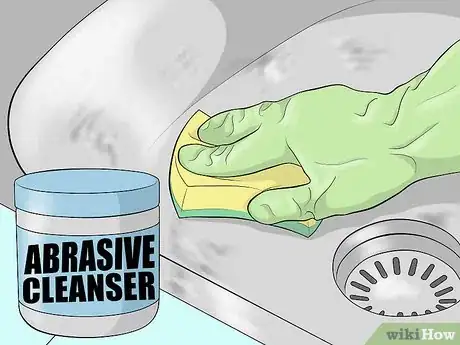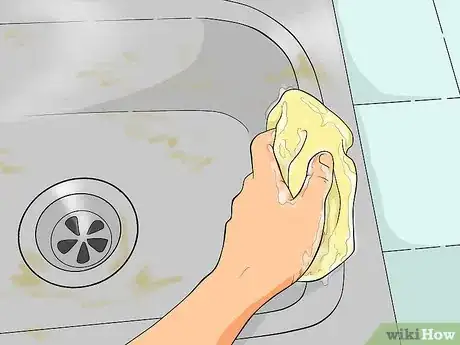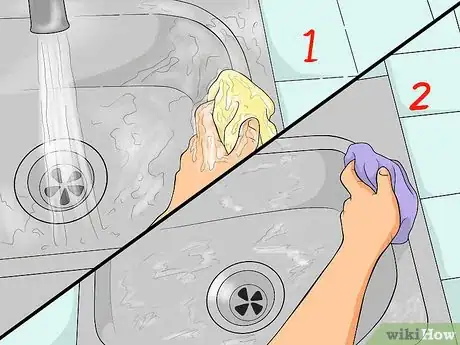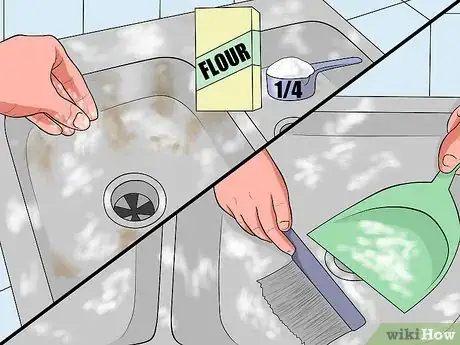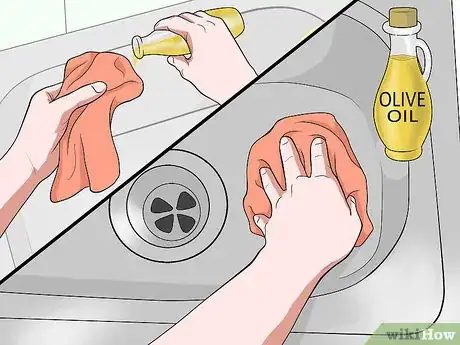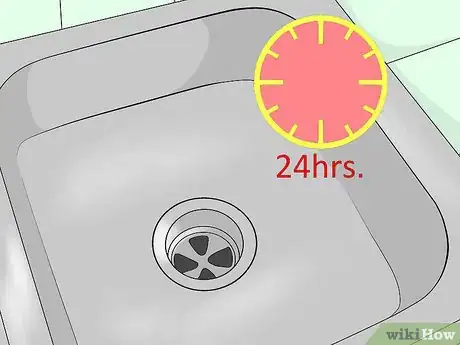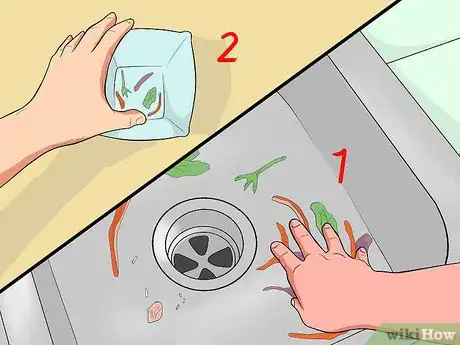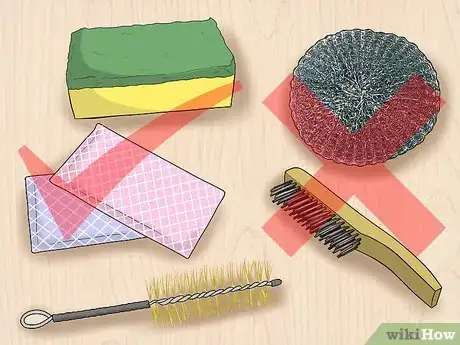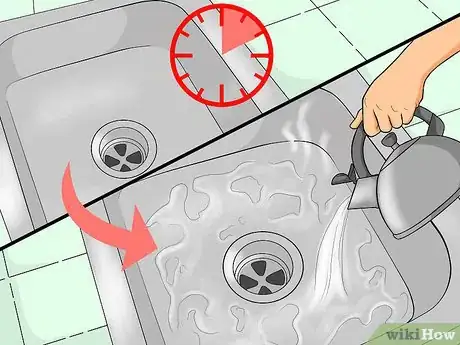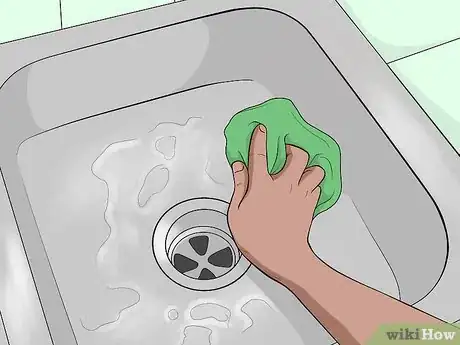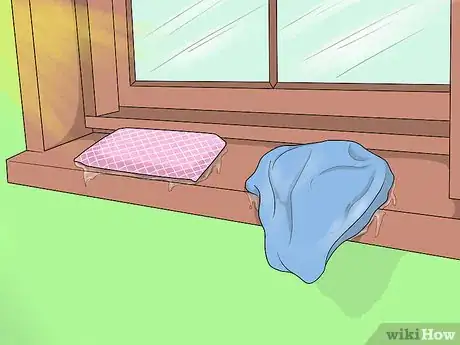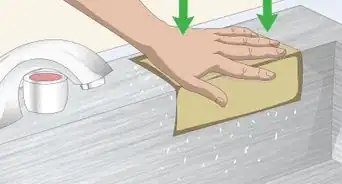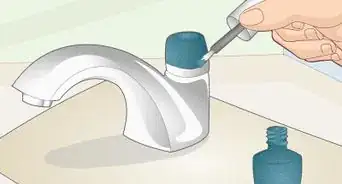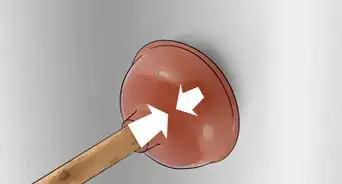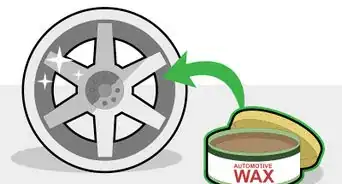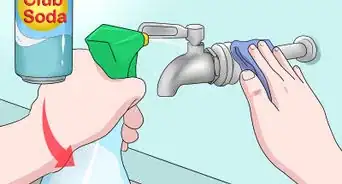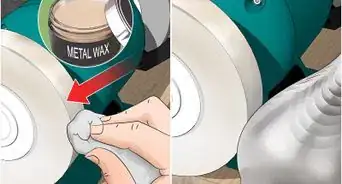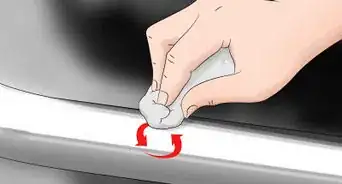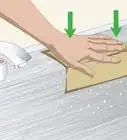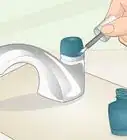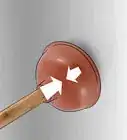This article was co-authored by NW Maids. NW Maids is a cleaning service in Seattle, Washington. NW Maids has been active since 2014 and has an emphasis on upfront pricing, easy online booking, and thorough cleaning services.
There are 12 references cited in this article, which can be found at the bottom of the page.
wikiHow marks an article as reader-approved once it receives enough positive feedback. In this case, 86% of readers who voted found the article helpful, earning it our reader-approved status.
This article has been viewed 497,905 times.
Long gone are the days when your stainless steel reflected your smiling face. But stop frowning at the dull, discolored surface: the right remedy can make a big improvement in just a few minutes. Once the sink is restored, a little upkeep every day or two should stop it sliding back.
Steps
Thorough Restoration
-
1Choose a moderate abrasive. Abrasives can scratch your sink's finish, so use them only for an occasional restoration project, or to remove stubborn stains. Try stainless steel polish, whiting, talc, or baking soda. Apply one of these to a slightly damp cloth.[1]
-
2Rub in the direction of the finish lines. Most stainless steel sinks have a brushed finish.[2] Wipe parallel to the brush lines to reduce the chance of a visible scratch.
- Use a toothbrush with a bit of the cleanser to clean the tight areas around the faucet, and the area around the drain.
Advertisement -
3Rinse the stainless steel cleanser off. Wash the cleanser off of everywhere you used it. If your sink's shine is restored, dry the sink completely with a clean towel, dabbing instead of rubbing to avoid streak marks. If your sink still looks dull, browse through the steps below for additional solutions to specific problems.
-
4
-
5Buff with flour if the sink is still grimy. Flour is a cheap, very mild abrasive, which makes it a good choice for cleaning a large area. If your sink still looks dirty and you have some spare time, follow these steps:[5]
- Dry the sink thoroughly. Any water left on the surface will turn the flour into glue.
- Sprinkle a light dusting of flour over the sink. Use about ¼ cup (60mL) flour for an average kitchen sink.[6]
- Buff the sink in a circular motion with a soft cloth, focusing on the rim and drain where food might get stuck.
- Once grime is removed, brush the flour into a container and throw it in the kitchen trash. Too much flour can block the drain.[7]
-
6Consider buffing with oil. Olive oil can boost the shine and remove streaks from your sink, but overdoing it can leave the stainless steel sticky or eventually make the appearance duller than before. If you try it, put just two or three drops of olive oil onto a soft cloth. Wipe the dry sink evenly until the entire surface is coated very lightly. Buff in small circles with the same oiled cloth for a couple minutes until you've achieved an even shine.[8]
-
7Keep the sink dry for 24 hours if feasible. A major clean can leave the surface of your sink temporarily damaged, especially if there was rust on the surface. Give the steel a day to restore its protective anti-rust layer, or at least dry it thoroughly after each use during this time.[9]
Regular Upkeep
-
1Clear out the sink. Wash and remove any dishes. Dispose of solid food debris.
- Wash steel and cast iron cookware promptly. These materials may cause rust if left in the sink too long.[10]
-
2Choose a non-abrasive cleaning tool. Sponges, soft cleaning pads, cloths, or bristle brushes are the best tools for scrubbing stainless steel. Abrasive pads and wire brushes may scratch the finish, especially if your sink has a shiny, reflective finish.[11]
- Never use steel wool or carbon steel brushes. These materials can leave behind small metal particles that cause rust.
-
3Scrub with warm water and gentle soap. For everyday cleaning, mild soap or dish detergent is enough to prevent discoloration or dulling.[12] Scrub until you've removed all debris and stains from the sink surface.
-
4Disinfect the surface occasionally. Kitchen sanitizer products with quaternary ammonia are among the most effective disinfectants for stainless steel, and should not damage your sink's finish.[13] However, they may irritate skin or cause asthma, and in some cases can damage aquatic life when washed down the drain.[14] White vinegar is a fairly effective alternative if you are concerned with these issues.[15] In either case, use a spray bottle to coat the surface of the sink.
- Most kitchen sanitizers that are not bleach-based contain quaternary ammonia. To confirm this, check the ingredients list for a chemical name ending in "ammonium chloride," or for an abbreviation such as BAC, BZK, BKC, or ADBAC.[16]
- Bleach-based cleaners are not recommended, as they can corrode your sink if not rinsed off thoroughly.[17] Never let bleach come into contact with residue from other cleaners, as the reaction can produce dangerous gas.
-
5Rinse with hot water. For best results, let the disinfectant sit for a least ten minutes before rinsing it off with hot water.[18]
-
6Wipe the sink dry. Water that evaporates on the sink surface can leave behind white spots, especially if you live in a hard water area. Wipe away moisture with a soft, dry cloth to preserve the sink's shine.[19]
-
7Dry scrubbing tools on a different surface. Wet sponges, clothes, or dish mats can trap water on the sink surface. This can cause stains or dull spots.[20] Squeeze out excess water, then place them on a windowsill or waterproof counter to dry instead.
Expert Q&A
Did you know you can get expert answers for this article?
Unlock expert answers by supporting wikiHow
-
QuestionHow do you make stainless steel shine again?
 NW MaidsNW Maids is a cleaning service in Seattle, Washington. NW Maids has been active since 2014 and has an emphasis on upfront pricing, easy online booking, and thorough cleaning services.
NW MaidsNW Maids is a cleaning service in Seattle, Washington. NW Maids has been active since 2014 and has an emphasis on upfront pricing, easy online booking, and thorough cleaning services.
House Cleaning Service
-
QuestionI have a new stainless steel sink in my apartment that is cheap and the finish on the "rim" where the faucets are is rough and has a whitish film. Is there any treatment to fix this?
 Community AnswerWrap a paper towel around the faucet and pour vinegar onto it and let it set for an hour, the take a toothbrush and scrub it off. It should be easy. Then rinse with water and dry with a clean cloth.
Community AnswerWrap a paper towel around the faucet and pour vinegar onto it and let it set for an hour, the take a toothbrush and scrub it off. It should be easy. Then rinse with water and dry with a clean cloth. -
QuestionHow can I keep stainless steel shiny?
 Community AnswerYou could use lemon oil, which is used to polish furniture. Rub It in going with the grain of the metal. Not only will it make your sink shiny, but it will help it repel water spots.
Community AnswerYou could use lemon oil, which is used to polish furniture. Rub It in going with the grain of the metal. Not only will it make your sink shiny, but it will help it repel water spots.
Warnings
- Wear rubber gloves when working with cleanser to protect your hands.⧼thumbs_response⧽
- Never mix household cleansers. Some products react to create dangerous gases.⧼thumbs_response⧽
- Some food pathogens can survive for hours or days on dry stainless steel surfaces.[21] Keeping your sink dry and free of debris reduces risk, but does not make it a sanitary surface for food preparation.⧼thumbs_response⧽
References
- ↑ http://www.ssina.com/download_a_file/cleaning.pdf
- ↑ http://www.ssina.com/download_a_file/cleaning.pdf
- ↑ https://www.jacknob.com/pdf/Cleaning%20SS.pdf
- ↑ http://digitalcommons.unl.edu/cgi/viewcontent.cgi?article=1682&context=extensionhist
- ↑ https://www.thekitchn.com/how-to-polish-stainless-steel-with-flour-cleaning-lessons-from-the-kitchn-208723
- ↑ http://www.bobvila.com/articles/how-to-polish-stainless-steel/
- ↑ https://food.thefuntimesguide.com/2010/08/garbage_disposals.php
- ↑ http://www.bobvila.com/articles/how-to-polish-stainless-steel/
- ↑ https://www.jacknob.com/pdf/Cleaning%20SS.pdf
- ↑ http://www.justmfg.com/care
- ↑ http://www.ssina.com/download_a_file/cleaning.pdf
- ↑ http://www.ssina.com/download_a_file/cleaning.pdf
- ↑ http://www.ssina.com/download_a_file/cleaning.pdf
- ↑ http://search.proquest.com/openview/8508f6cdd54d5692d03ff82c87ed844f/1?pq-origsite=gscholar
- ↑ http://search.proquest.com/openview/8508f6cdd54d5692d03ff82c87ed844f/1?pq-origsite=gscholar
- ↑ https://www.med.nyu.edu/pophealth/sites/default/files/pophealth/QACs%20Info%20for%20Physicians_18.pdf
- ↑ http://www.us.kohler.com/us/Stainless-Steel-Kitchen-Sinks/content/CNT900099.htm?locale=en_US
- ↑ http://foodsafety.wisc.edu/consumer/fact_sheets/Cleaners_Sanitizers.pdf
- ↑ http://www.us.kohler.com/us/Stainless-Steel-Kitchen-Sinks/content/CNT900099.htm?locale=en_US
- ↑ http://www.justmfg.com/care
- ↑ http://www.sciencedirect.com/science/article/pii/S0168160502005408
About This Article
To clean a dull stainless steel sink, start by applying some baking soda to the sink and rubbing it in with a damp cloth in the direction of the steel’s grain. Next, rinse the baking soda off with water, then dry it with a clean towel. If you can still see white spots or rust, dip a soft cloth into vinegar and use it to wipe them away. To add even more shine to a dull sink, try buffing it with a soft cloth and 3 drops of olive oil. Once the entire surface is very lightly coated, rub the oil in with the cloth in small circles until the sink is shiny. For tips on how to keep your sink from getting dull and grimy again with daily upkeep, read on!
